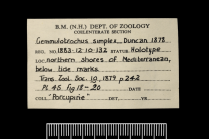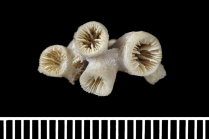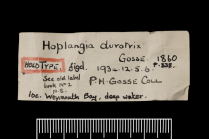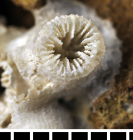WoRMS taxon details
Hoplangia Gosse, 1860
135094 (urn:lsid:marinespecies.org:taxname:135094)
accepted
Genus
Hoplangia durotrix Gosse, 1860 (type by monotypy)
Gemmulatotrochus Duncan, 1878 · unaccepted > junior subjective synonym
Gemmulatrochus Duncan, 1878 † · unaccepted > junior subjective synonym
Microcyathus Döderlein, 1913 · unaccepted > junior subjective synonym
Soljania Pax, 1955 · unaccepted > junior subjective synonym
- Species Hoplangia durotrix Gosse, 1860
- Species Hoplangia pallaryi Joubin, 1930 accepted as Cladocora caespitosa (Linnaeus, 1767) (unaccepted > junior subjective synonym)
marine, fresh, terrestrial
recent only
Gosse, P.H., 1860. Actinologia Britannica. A history of the British sea-anemones and corals. London: Van Voorst : pp. i-xl, 1-362. [details]
Depth range 0-150 m
Depth range 0-150 m [details]
Hoeksema, B. W.; Cairns, S. (2024). World List of Scleractinia. Hoplangia Gosse, 1860. Accessed through: World Register of Marine Species at: https://www.marinespecies.org/aphia.php?p=taxdetails&id=135094 on 2024-05-02
Date
action
by
2006-09-13 06:47:38Z
changed
Martinez, Olga
![]() The webpage text is licensed under a Creative Commons Attribution 4.0 License
The webpage text is licensed under a Creative Commons Attribution 4.0 License
original description
Gosse, P.H., 1860. Actinologia Britannica. A history of the British sea-anemones and corals. London: Van Voorst : pp. i-xl, 1-362. [details]
original description (of Gemmulatotrochus Duncan, 1878) Duncan PM. (1878). A Description of the Madreporaria dredged up during the Expeditions of H.M.S. Porcupine' in 1869 and 1870. – Part. II. <em>Transactions of the Zoological Society of London.</em> 10: 235-249, pls. 43-45., available online at https://doi.org/10.1111/j.1096-3642.1873.tb00560.x [details]
original description (of Microcyathus Döderlein, 1913) Döderlein L. (1913). Die Steinkorallen aus dem Golf von Neapel. <em>Mitteilungen aus der Zoologischen Station zu Neapel.</em> 21: 105-152, pls. 7-9. [details]
original description (of Soljania Pax, 1955) Pax F. (1955). Ein neuer Gattungsname für eine Adariatscihe Steinkoralle. <em>Bulletin scientifique du Conseil des académies de la RPF de Yougoslavie.</em> 2(3): 75-76. [details]
basis of record Cairns, S.D., Hoeksema, B.W., and J. van der Land, 2001. Scleractinia, <B><I>in</I></B>: Costello, M.J. <i>et al.</i> (Ed.) (2001). <i>European register of marine species: a check-list of the marine species in Europe and a bibliography of guides to their identification. Collection Patrimoines Naturels,</i> 50: pp. 109-110 (look up in IMIS) [details]
additional source Neave, Sheffield Airey. (1939-1996). Nomenclator Zoologicus vol. 1-10 Online. <em>[Online Nomenclator Zoologicus at Checklistbank. Ubio link has gone].</em> , available online at https://www.checklistbank.org/dataset/126539/about [details]
additional source Cairns, S.D., R. Baron-Szabo, A.F. Budd, B. Lathuilière, E. Roniewicz, J. Stolarski & K.G. Johnson. (2010). Corallosphere. , available online at http://www.corallosphere.org [details]
redescription Cairns, S.D. (1995). The marine fauna of New Zealand: Scleractinia (Cnidaria: Anthozoa. <em>New Zealand Oceanographic Memoir.</em> 103: 1-210. [details] Available for editors [request]
[request]
original description (of Gemmulatotrochus Duncan, 1878) Duncan PM. (1878). A Description of the Madreporaria dredged up during the Expeditions of H.M.S. Porcupine' in 1869 and 1870. – Part. II. <em>Transactions of the Zoological Society of London.</em> 10: 235-249, pls. 43-45., available online at https://doi.org/10.1111/j.1096-3642.1873.tb00560.x [details]
original description (of Microcyathus Döderlein, 1913) Döderlein L. (1913). Die Steinkorallen aus dem Golf von Neapel. <em>Mitteilungen aus der Zoologischen Station zu Neapel.</em> 21: 105-152, pls. 7-9. [details]
original description (of Soljania Pax, 1955) Pax F. (1955). Ein neuer Gattungsname für eine Adariatscihe Steinkoralle. <em>Bulletin scientifique du Conseil des académies de la RPF de Yougoslavie.</em> 2(3): 75-76. [details]
basis of record Cairns, S.D., Hoeksema, B.W., and J. van der Land, 2001. Scleractinia, <B><I>in</I></B>: Costello, M.J. <i>et al.</i> (Ed.) (2001). <i>European register of marine species: a check-list of the marine species in Europe and a bibliography of guides to their identification. Collection Patrimoines Naturels,</i> 50: pp. 109-110 (look up in IMIS) [details]
additional source Neave, Sheffield Airey. (1939-1996). Nomenclator Zoologicus vol. 1-10 Online. <em>[Online Nomenclator Zoologicus at Checklistbank. Ubio link has gone].</em> , available online at https://www.checklistbank.org/dataset/126539/about [details]
additional source Cairns, S.D., R. Baron-Szabo, A.F. Budd, B. Lathuilière, E. Roniewicz, J. Stolarski & K.G. Johnson. (2010). Corallosphere. , available online at http://www.corallosphere.org [details]
redescription Cairns, S.D. (1995). The marine fauna of New Zealand: Scleractinia (Cnidaria: Anthozoa. <em>New Zealand Oceanographic Memoir.</em> 103: 1-210. [details] Available for editors
 Present
Present  Inaccurate
Inaccurate  Introduced: alien
Introduced: alien  Containing type locality
Containing type locality
From editor or global species database
Diagnosis Colonial corallum formed by extratentacular budding from a common basal coenosteum; calices arranged in phaceloid to plocoid manner; axial edges of septa smooth; pali, columella, and endotheca absent [details]Remark Once considered as a subgenus of Astrangia (family Rhizangiidae), it is now considered a caryophylliid (Zibrowius, 1980). The genus is monotypic and has no fossil record. Cairns (1995) suggested that the New Zealand occurrence may have been introduced during WWII. [details]
From other sources
Biology azooxanthellate [details]Depth range 0-150 m [details]







